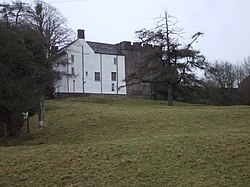Difference between revisions of "Penhow Castle"
(Created page with "{{Infobox castle |name=Penhow Castle |county=Monmouthshire |village=Penhow |os grid ref= |picture=Penhow Castle, a house of two halves - geograph.org.uk - 1725875.jpg |picture...") |
|||
| Line 14: | Line 14: | ||
|battles= | |battles= | ||
}} | }} | ||
| − | '''Penhow Castle''' is a mediæval castle in the village of [[Penhow]] to east of [[Newport, Monmouthshire|Newport]], [[Monmouthshire]]. It was built as a home for Sir Roger de St Maur, one of the Norman knights who served the Norman Lord of Striguil at [[Chepstow Castle]]. He built a tower house by 1129 and it has been continuously inhabited ever since. It was the first British home of the family who would later rise to national prominence under the more familiar name of "Seymour", the ancestors of Queen Jane Seymour and King Edward VI. Later the Seymour family sold Penhow Castle to the Lewis family of [[St Pierre, Monmouthshire|St Pierre]], who converted the castle to a modern residence in 1674. Thomas Lewis' son Thomas was High Sheriff of the county, and married the daughter of Sir Richard Levett, Lord Mayor of London. The Lewis family retained ownership of Penhow Castle for several centuries.<ref>[http://www.castlewales.com/penhow.html Penhow Castle, castlewales.com]</ref> | + | '''Penhow Castle''' is a mediæval castle in the village of [[Penhow]] to the east of [[Newport, Monmouthshire|Newport]], [[Monmouthshire]]. It was built as a home for Sir Roger de St Maur, one of the Norman knights who served the Norman Lord of Striguil at [[Chepstow Castle]]. He built a tower house by 1129 and it has been continuously inhabited ever since. It was the first British home of the family who would later rise to national prominence under the more familiar name of "Seymour", the ancestors of Queen Jane Seymour and King Edward VI. Later the Seymour family sold Penhow Castle to the Lewis family of [[St Pierre, Monmouthshire|St Pierre]], who converted the castle to a modern residence in 1674. Thomas Lewis' son Thomas was High Sheriff of the county, and married the daughter of Sir Richard Levett, Lord Mayor of London. The Lewis family retained ownership of Penhow Castle for several centuries.<ref>[http://www.castlewales.com/penhow.html Penhow Castle, castlewales.com]</ref> |
The castle, which has a reputation for being haunted,<ref>[http://www.psychicinvestigations.net/html/psychic_investigations_3.html Psychic investigation at Penhow Castle]</ref> was open to the public between 1978 and 2002.<ref>[http://news.bbc.co.uk/1/hi/wales/2618151.stm Penhow Castle closes to the public]</ref> | The castle, which has a reputation for being haunted,<ref>[http://www.psychicinvestigations.net/html/psychic_investigations_3.html Psychic investigation at Penhow Castle]</ref> was open to the public between 1978 and 2002.<ref>[http://news.bbc.co.uk/1/hi/wales/2618151.stm Penhow Castle closes to the public]</ref> | ||
==References== | ==References== | ||
{{reflist}} | {{reflist}} | ||
Latest revision as of 18:34, 15 April 2015
| Penhow Castle | |
|
Monmouthshire | |
|---|---|

| |
| Location | |
| Location: | 51°36’54"N, 2°50’6"W |
| Village: | Penhow |
| History | |
| Information | |
| Condition: | Intact |
| Owned by: | Private |
Penhow Castle is a mediæval castle in the village of Penhow to the east of Newport, Monmouthshire. It was built as a home for Sir Roger de St Maur, one of the Norman knights who served the Norman Lord of Striguil at Chepstow Castle. He built a tower house by 1129 and it has been continuously inhabited ever since. It was the first British home of the family who would later rise to national prominence under the more familiar name of "Seymour", the ancestors of Queen Jane Seymour and King Edward VI. Later the Seymour family sold Penhow Castle to the Lewis family of St Pierre, who converted the castle to a modern residence in 1674. Thomas Lewis' son Thomas was High Sheriff of the county, and married the daughter of Sir Richard Levett, Lord Mayor of London. The Lewis family retained ownership of Penhow Castle for several centuries.[1]
The castle, which has a reputation for being haunted,[2] was open to the public between 1978 and 2002.[3]